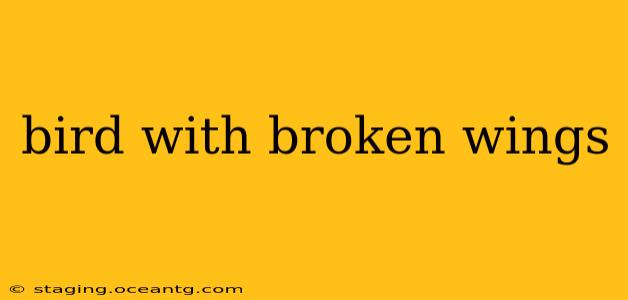Finding a bird with broken wings is a heartbreaking sight. These magnificent creatures, symbols of freedom and flight, are utterly vulnerable when injured. This comprehensive guide will explore the challenges faced by birds with broken wings, the potential causes, and the crucial steps to take if you encounter one. We will also delve into the complexities of avian rehabilitation and the importance of professional help.
What Causes Broken Wings in Birds?
Several factors can lead to a bird suffering a broken wing. Understanding these causes is crucial for prevention and responsible wildlife interaction:
- Collisions: Collisions with cars, windows, and other human-made structures are a major cause of wing injuries in birds. Birds often don't perceive glass as a solid barrier.
- Predation Attacks: Attacks from cats, dogs, or other predators can result in broken bones and other serious injuries.
- Natural Disasters: Storms, wildfires, and other natural disasters can inflict significant trauma on birds, including broken wings.
- Human Interaction: Unfortunately, intentional or accidental harm from humans also contributes to avian injuries.
What are the Signs of a Broken Wing in a Bird?
Identifying a broken wing can be challenging, but several key indicators can help:
- Visible Deformity: A noticeably bent or twisted wing is a clear sign of a fracture.
- Swelling and Bruising: The injured area may appear swollen and bruised.
- Inability to Fly: The most obvious sign is the bird's inability to fly or its difficulty in doing so.
- Pain and Distress: The bird will likely show signs of pain and distress, such as labored breathing or unusual vocalizations.
- Abnormal Posture: The bird may hold its wing close to its body or at an unnatural angle.
What Should I Do If I Find a Bird with a Broken Wing?
Finding a bird with a broken wing requires a calm and measured response. Here's what you should do:
- Assess the Situation: Observe the bird from a safe distance. Do not approach it directly if it appears aggressive or overly stressed.
- Ensure Your Safety: Always prioritize your safety. Wear gloves to protect yourself from bites or scratches.
- Contact Wildlife Rehabilitation: Your first step should be contacting a local licensed wildlife rehabilitator or animal rescue organization. They are equipped with the knowledge and resources to provide proper care. Do not attempt to treat the bird yourself.
- Provide Temporary Shelter: If contacting a rehabilitator immediately isn't possible, provide temporary shelter in a dark, quiet, and safe box lined with soft material. Keep it away from pets and children. Avoid giving the bird food or water unless instructed by a professional.
Can a Bird Recover from a Broken Wing?
The prognosis for a bird with a broken wing depends on several factors, including the severity of the fracture, the bird's overall health, and the quality of care received. With proper veterinary care and rehabilitation, many birds can make a full recovery and return to the wild. However, some injuries may be too severe, resulting in lifelong disability or even death.
What Happens During Avian Rehabilitation?
Avian rehabilitation is a complex process that involves skilled professionals who understand the unique needs of birds. Treatment typically involves:
- Veterinary Assessment: A veterinarian will examine the bird, assess the injury, and determine the appropriate course of action. This may include X-rays to confirm the fracture.
- Immobilization: The broken wing will need to be immobilized using a splint or cast to allow the bones to heal properly.
- Pain Management: Pain medication may be administered to ensure the bird's comfort during recovery.
- Nutrition and Hydration: Providing proper nutrition and hydration is crucial for healing.
- Physical Therapy: Once the fracture has healed, physical therapy may be necessary to help the bird regain its strength and mobility.
- Release Back into the Wild: The ultimate goal of avian rehabilitation is to release the bird back into its natural habitat once it has fully recovered.
How Can I Prevent Birds from Getting Injured?
Preventing avian injuries is crucial. Here are some steps you can take:
- Cat Containment: Keep cats indoors to prevent them from preying on birds.
- Window Treatments: Use window decals or other bird-deterrents to make windows more visible to birds.
- Safe Driving: Be mindful of birds when driving, especially during migration seasons.
- Responsible Landscaping: Avoid using harmful pesticides or herbicides that could affect birds.
Finding a bird with broken wings is a challenging situation, but with swift action and the help of wildlife professionals, there's hope for recovery. Remember, intervention is key. Contacting a local wildlife rehabilitator is always the best first step. Their expertise ensures the bird receives the best possible chance at a full recovery and a return to its natural freedom.
